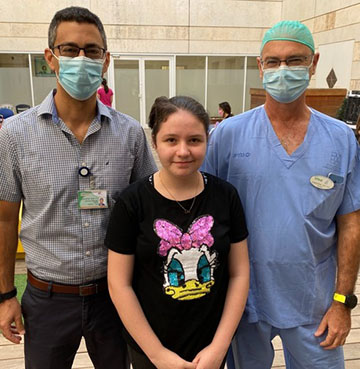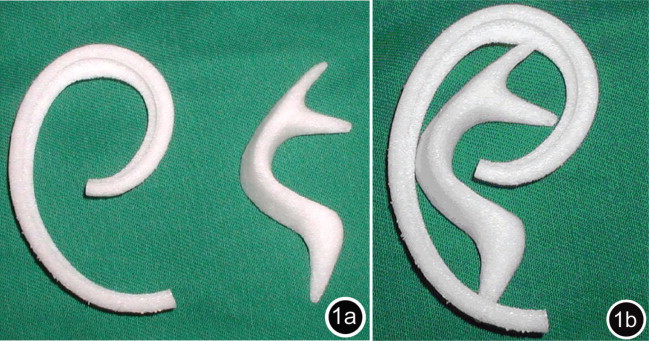What is the Medpor technique?
First introduced in 1991, MEDPOR ear reconstruction is a surgical technique which replaces the traditional Rib Cartilage Ear Reconstruction.
Since it’s inception, hundreds of thousands of MEDPOR reconstruction surgeries were performed around the world.
The key difference between MEDPOR and rib cartilage ear reconstructions is the material used to rebuild the ear. Where MEDPOR uses a microporous high-density polyethylene implant, rib cartilage ear reconstruction uses the patient’s natural tissue as the framework. This procedure requires an initial surgery to collect cartilage from the rib cage.

In the picture: the surgeons and a patient after a successful Medpor reconstruction
Photo credit: Schneider Children's hospital
MEDPOR Ear reconstruction for Atresia
The Medpor approach can easily be integrated with an Atresia reconstruction to improve hearing. The specialists in the Ears, Nose and Throat department and plastic surgeons coordinate to achieve a successful ear canal reconstruction which will restore the patients’ hearing.
Medpor ear reconstruction uses a high-density porous polyethylene implant to provide the normal contours and projection of the ear in a single surgery.
The Medpor implant is made up of two pieces that are custom assembled to provide the new ear with a similar size and shape and details of a normal ear. The pore structure of the Medpor allows for growth of the patient’s tissue into the implant. While the implant is not a living tissue, this tissue ingrowth helps provide resilience to infection.
Reconstruction with the MEDPOR technique usually can begin around age three. If only one ear is involved, the MEDPOR framework is customized to match the normal ear but is created slightly larger in younger children so the ear will be adult-sized. To determine the size, the surgeon will take into account anatomical growth chart projections, the current size of the other ear, and the size of the biological parents’ ears.
The framework is then covered by the patient's own tissue (called a flap) which is brought down as a thin "living membrane" from underneath the scalp. This approach enables them to harvest the "living membrane" flap without any incisions on the scalp, hiding the scar behind the new ear. The flap is often covered with better colored skin from the head, which usually leaves no scar.
The MEDPOR framework is porous. Therefore, surrounding blood vessels and skin can integrate with the material.

Advantages of MEDPOR Ear Reconstruction
MEDPOR ear reconstruction for microtia patients offers distinct advantages over other techniques.
These include:
- Reconstruction may start as early as age three with consistent results.
- Patients with hearing loss due to atresia (absence of an ear canal) may undergo canal reconstruction as early as three years of age, and experience better hearing and an improved ability to process and learn language.
- Minimal pain associated with the reconstruction enabling most patients to go home after the procedure
- Reconstruction may be completed in one or two outpatient surgeries
- A low hairline or hemifacial microsomia does not compromise the result of the ear reconstruction
- The reconstructed ear is designed to match the normal ear in size and projection, which eliminates the need to surgically "pin back" the normal ear. At age three, a child's ear is approximately 80 to 85 percent of an adult-sized ear so the MEDPOR ear is constructed 15 to 20 percent bigger so they'll match when the child is older
- Six to eight weeks after surgery, MEDPOR ears are able to withstand the rigors of most sports. Protective helmets are recommended for contact sports such as wrestling or football.
The MEDPOR surgery process
During the surgery the Medpor ear implant is covered with a thin layer of tissue from the scalp (superficial temporoparietal fascia) and skin from the ears. This thin layer of scalp tissue supports the survival of the skin grafts and allows for the delicate features of the ear to be created. The skin on the front of the ear is ear skin from around the microtic ear and from the back of the unaffected ear. The color match of the skin covering the back of the ear is less important cosmetically, therefore harvesting from the groin crease is preferred because it leaves the donor scar that is hidden in the under-wear line. In our experience, the average ear reconstruction from the Medpor approach looks like a normal ear after a single surgery and alleviates unwanted attention.










